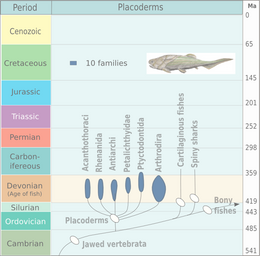
A | B | C | D | E | F | G | H | CH | I | J | K | L | M | N | O | P | Q | R | S | T | U | V | W | X | Y | Z | 0 | 1 | 2 | 3 | 4 | 5 | 6 | 7 | 8 | 9
| Arthrodira Temporal range: Devonian,
| |
|---|---|

| |
| Artist's reconstruction of the arthrodire placoderm Dunkleosteus terrelli | |
| Scientific classification | |
| Domain: | Eukaryota |
| Kingdom: | Animalia |
| Phylum: | Chordata |
| Infraphylum: | Gnathostomata |
| Class: | †Placodermi |
| Order: | †Arthrodira Woodward, 1891 |
| Subgroups | |
Arthrodira (Greek for "jointed neck") is an order of extinct armored, jawed fishes of the class Placodermi that flourished in the Devonian period before their sudden extinction, surviving for about 50 million years and penetrating most marine ecological niches. Arthrodires were the largest and most diverse of all groups of placoderms.[1]
Description
Arthrodire placoderms are notable for the movable joint between armor surrounding their heads and bodies. Like all placoderms, they lacked distinct teeth; instead, they used the sharpened edges of a bony plate on their jawbone as a biting surface. The eye sockets are covered by a bony ring, which supports the eye, a feature shared by birds and some ichthyosaurs. Early arthrodires, such as the genus Arctolepis, were well-armoured fishes with flattened bodies. The largest member of this group, Dunkleosteus, was a true superpredator of the latest Devonian period, reaching as much as 6 m in length. In contrast, the long-nosed Rolfosteus measured just 15 cm.[2] Fossils of Incisoscutum have been found containing unborn fetuses, indicating that arthrodires gave birth to live young.[3][4]
A common misconception is the arthrodires (along with all other placoderms) were sluggish bottom-dwellers that were outcompeted by more advanced fish. Leading to this misconception is that the arthrodire body plan remained relatively conserved (that is, the majority of arthrodires were bullet- or torpedo-shaped) during the Devonian period, save for increasing in size. However, during their reign, the arthrodires were one of the most diverse and numerically successful, if not the most successful, vertebrate orders of the Devonian, occupying a vast spectrum of roles from apex predator to detritus-nibbling bottom dweller. Despite their success, the arthrodires were one of many groups eliminated by the environmental catastrophes of the Late Devonian extinction, allowing other fish such as sharks to diversify into the vacated ecological niches during the Carboniferous period.[citation needed]

Phylogeny
The order Arthrodira belongs to the class Placodermi, the large group of extinct prehistoric armored fish that is thought to have diverged over 400 million years ago from all sharks and bony fishes (and thus also all subsequent tetrapods, including mammals, birds, reptiles and amphibians). However, recent phylogenetic studies have found Placodermi to be paraphyletic, and rather an evolutionary grade towards Eugnathostomata, the clade grouping that contains sharks, bony fish, and all tetrapods.[6][7]
Arthrodira was traditionally divided into the paraphyletic Actinolepida, the Phlyctaenii (now also paraphyletic), and the Brachythoraci.[8] Phylogenetic studies have since found two of those groups as paraphyletic, as shown in the cladogram below, from Dupret et al. (2009).[9]
